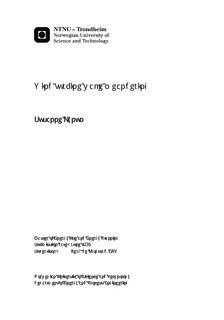| dc.description.abstract | In this master thesis the meandering of the wake of a three bladed horizontal axis model wind turbine has been studied. Measurements have been conducted by the use of four hot-wire probes located at multiple nearby points in the wake at X/D = 1, 3 and 5 downstream the model wind turbine. The meandering has been studied based on the location of the tip vortices shed by the turbine blades. The experiments were conducted in the wind tunnel at NTNU at the Department of Energy and Process Engineering. The aim of the study was to see the effect on the meandering of the wake of the model turbine when placed in an incoming flow with turbulence intensity typical for atmospheric turbulence, compared to an incoming flow with a low turbulence intensity round 0.3 %. The atmospheric turbulence was generated by inserting a grid in the inlet to the test section in the wind tunnel. The grid generated a turbulence intensity round 5.5 % and integral length scales of Luuz = 3.1E-2 m and Luux = 6.5E-2 m at the position of the model wind turbine in the tunnel. The performance of the model turbine in both incoming flows was calculated based on measurements of the thrust and torque acting on the turbine in a free stream velocity of 10 m/s. The greatest deviation in the performance curve was found at the top of the curve; however the difference between the two cases was minor. Initial measurements with a single hot-wire probe was conducted in the wake of the turbine to locate the tip vortices. Based on these results, the location to conduct the multiple hot-wire measurements was decided. Already at this stage the effect of the grid turbulence was evident due to the smeared out energy in the flow in the wake caused by diffusion and mixing. The tip speed ratio (TSR) of the model wind turbine was 6 in the case without grid generated turbulence, and 7 in the case with grid turbulence during the final measurements in the wake. The effect of the change in TSR was evaluated, and it was found that new measurements were not needed. The normal stress based on the velocity measurements in the wake were phase averaged according to the position of the turbine blade using Matlab. When comparing these results with the normal stress calculated directly from the time series, it was found that the tip vortices had merged together or broken up at all measurement point except at X/D = 1 downstream the turbine without grid generated turbulence. Using power spectral density function (PSD) the observations were confirmed.The tip vortices was not equally distributed within the wake and were located 30°, 128° and 224° at respectively z/R =1.12, 1.15 and 1.20. Their diameters were found to be 1.8E-2 m, 1.35E-2 m, 2.7E-2 m in z direction. The location of the peak in the normal stress tended to meander a bit back and forth, mainly directed towards the rotor center, with a distance from 4.5E-3 m to 1.8E-2 m, and in the streamwise direction with a total distance of 6.17E-2 m. The tip vortices seem to meander individually within the wake, and not with the same distance.Based on the results and observations conducted throughout this study, new measurements should be conducted at a shorter distance to the turbine rotor to be able to compare the meandering of the wake for the two different incoming flows. | nb_NO |

